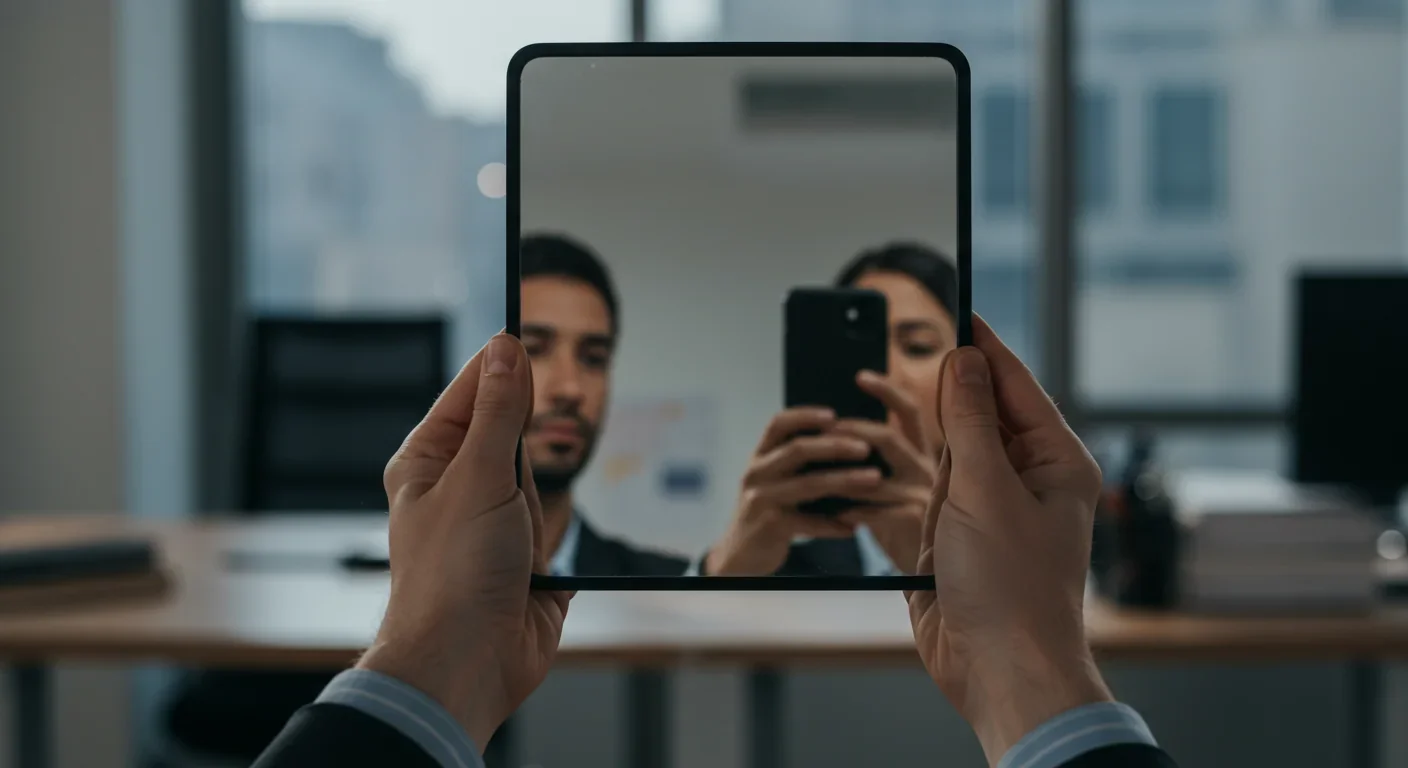Why Your Brain Is Hardwired to Lose Money

TL;DR: Authenticity paradox reveals staying true to yourself can limit growth. Research shows authentic leadership anchors in values, not fixed behaviors, allowing strategic evolution without betraying core identity.

Within the next decade, you'll likely face a choice that feels impossible: stay true to yourself or adapt to succeed. Research suggests this isn't just a personal dilemma—it's a fundamental tension reshaping how we lead, work, and grow. The very quality we're told builds trust and connection might also be the thing keeping us stuck.
Authenticity has become the holy grail of modern leadership and personal development. Bill George's research on authentic leadership shows that people won't follow you unless they trust you, and they won't trust you unless you're authentic. Studies confirm that authentic leadership increases trust and work engagement while facilitating better conflict management.
But there's a catch. Herminia Ibarra, organizational behavior professor at London Business School, discovered something that challenges everything we've been told. To grow as a leader, you have to do things that don't come naturally. That's how we expand our range. Being "too authentic" can mean resisting change under the banner of integrity.
This is the authenticity paradox: the trait that makes you trustworthy can simultaneously limit your evolution.
Think about the last time you had to step into a bigger role. Maybe you became a manager, started a company, or took on a public-facing position. That moment when you realize the behaviors that got you here won't get you there—but changing feels like betraying yourself. That's not weakness. It's the paradox at work.
The problem starts with how we define authenticity. Most people think it means staying the same—being consistent, predictable, "true to yourself." Psychology research reveals this is fundamentally wrong.
Authentic leadership isn't about rigid consistency. It's defined by four dimensions: self-awareness (understanding your strengths and limitations), relational transparency (presenting your genuine self to others), balanced processing (objectively analyzing information before making decisions), and internalized moral perspective (being guided by internal moral standards).
Notice what's missing? There's nothing about staying the same person forever.
Authentic leadership is the healthy alignment between internal values and beliefs and external behavior. The key word is "alignment," not "rigidity."
When founders and executives resist new leadership behaviors, they often justify it as staying authentic. But psychological rigidity—the inability to adapt behavior to changing contexts—is different from authenticity. One is about values, the other about habits.
Consider the creative entrepreneur who built a scrappy startup through sheer force of personality. As the company grows, investors want polished presentations and strategic planning. The founder feels this shift as a loss of soul. "That's not who I am," they say. But is it?
Research on authentic leadership in founders shows this inflection point—the shift from doing to delegating—is where authenticity often feels lost. Many founders question their identity precisely when they need to evolve most.
The psychological cost is real. When you cling to an outdated version of yourself, you're not preserving authenticity—you're practicing avoidance. Studies show that leaders who can't adapt their style to different contexts struggle with effectiveness, even when they're deeply self-aware.
Here's where it gets tricky: sometimes what feels authentic is just what's familiar. Your brain has spent years optimizing for a particular way of being. Change triggers discomfort, which your mind interprets as wrongness. But discomfort and inauthenticity aren't the same thing.

A software engineer who's brilliant at code might feel fake giving presentations. A detail-oriented analyst might feel phony practicing big-picture thinking. An introvert in a leadership role might feel inauthentic networking. These feelings are valid—but they're not evidence you're betraying yourself. They're evidence you're growing.
Research on code-switching among professionals from underrepresented backgrounds reveals this tension acutely. Adapting communication styles to different audiences can feel like losing your authentic self, but it can also be a strategic tool for navigating systems not designed with you in mind. The question isn't whether to adapt, but how to do it without losing your center.
Emotional intelligence offers a way through this paradox. Meta-analytic research confirms that authentic leadership is significantly related to emotional intelligence, and that high-EI leaders can better discern when it's most appropriate to employ authentic behaviors.
That last part is crucial. Authenticity isn't always appropriate. Being authentic and practicing honesty isn't a license to behave without filters, political savvy, or good judgment.
Imagine a leader who's having a terrible day and decides to be authentic about their frustration in a high-stakes client meeting. That's not courage—it's poor judgment. Authenticity without context becomes a liability.
The solution isn't to abandon authenticity. It's to anchor yourself in values rather than personality traits. Your values—integrity, curiosity, fairness, innovation—can remain constant while your behaviors evolve. You don't need to stay the same person forever, but you do need to stay aligned with your values.
This distinction transforms everything. When you anchor in values, you can experiment with new leadership behaviors without feeling fake. A naturally direct communicator learning diplomacy isn't betraying authenticity—they're expanding their toolkit while maintaining their value of honest communication.
Carol Dweck's research on growth mindset intersects powerfully with the authenticity paradox. If you believe your personality is fixed—a "growth mindset" about your identity—then any change feels inauthentic. But if you see yourself as capable of development, authenticity becomes dynamic rather than static.
Authentic leaders continually seek opportunities to learn and grow through feedback, action, experience, and reflection. The operative word is "continually." Growth is built into authentic leadership, not opposed to it.
Training can help. Studies show that with proper intervention, you can expect significant increase in authentic leadership skills after just 12 one-hour sessions of training. The research suggests authenticity is partly learnable, which contradicts the notion that you either "have it" or don't.
Think about musicians. A jazz pianist learning classical technique doesn't stop being a jazz musician. They're expanding their range. The same applies to professional identity. You're not replacing yourself—you're adding capabilities.
The psychological flexibility research supports this. Flexibility is the ability to adapt behavior to align with values in changing contexts. It's the opposite of rigidity, which maintains the same behavior regardless of context. Flexibility serves authenticity; rigidity undermines it.
The authenticity paradox plays out differently across cultures. In individualistic Western cultures, authenticity often means expressing your unique self. In collectivist cultures, authenticity might mean fulfilling your role in the community harmoniously.
Research on cultural variations shows that what counts as authentic leadership varies significantly. A leader seen as appropriately authentic in Silicon Valley might be viewed as self-centered in Tokyo. A leader considered authentic in Germany might seem cold in Brazil.
This cultural layer adds complexity. Global leaders need to navigate not just personal authenticity, but cultural expectations of what authenticity looks like. The solution isn't cultural code-switching that feels hollow, but understanding that authentic expression has cultural grammar.
For professionals from marginalized backgrounds, this tension multiplies. Code-switching research reveals it can be both a survival strategy and a source of cognitive load. The pressure to adapt to dominant culture norms while maintaining cultural identity creates a unique version of the authenticity paradox.
The question becomes: Can you honor your cultural background while adapting to professional contexts? The answer is yes, but it requires what researchers call "integrated authenticity"—consciously choosing which aspects of yourself to emphasize in different settings without abandoning your core.

Impostor syndrome and the authenticity paradox are cousins. When you're in a new role that requires new behaviors, you often feel like an impostor. Research on impostor syndrome shows it's especially common during transitions and among high achievers.
But there's a twist. Some psychologists argue impostor syndrome can drive authentic leadership by keeping you humble, open to feedback, and connected to others' experiences of struggle.
The problem arises when impostor feelings prevent experimentation. If every new behavior triggers "I'm a fraud" thoughts, you'll retreat to familiar patterns even when they no longer serve you. This creates a self-reinforcing loop where staying in your comfort zone feels authentic, and growth feels fake.
Breaking this loop requires reframing impostor feelings as growth signals rather than authenticity warnings. Feeling like an impostor often means you're challenging yourself. That's not a bug—it's a feature.
The rise of personal branding adds another layer to this paradox. Marketing experts emphasize that every entrepreneur needs a personal brand—a carefully curated public persona.
But doesn't curation contradict authenticity? Not necessarily. Strategic self-presentation isn't lying; it's choosing which truths to emphasize. You contain multitudes. Your brand highlights the aspects most relevant to your audience and goals.
The key is whether your brand is rooted in genuine values and capabilities, or fabricated from whole cloth. An introvert who presents as thoughtful and strategic isn't being inauthentic. An introvert who presents as the life of the party is.
Research suggests authenticity isn't about showing everything to everyone. It's about showing up honestly in ways that serve both your values and your context. That's not duplicity—it's wisdom.
So how do you actually do this? How do you grow without losing yourself?
Anchor in values, not behaviors. List your core values—not what you do, but what matters to you. Integrity, curiosity, fairness, impact. These can remain constant while your behaviors evolve. When facing a new challenge, ask: Which behavior serves my values in this context?
Experiment deliberately. Try new leadership behaviors as experiments, not commitments. Research recommends experimenting with new approaches while explicitly naming them as experiments. This reduces the stakes and separates identity from behavior. You're not changing who you are; you're testing what works.
Reflect systematically. After experimenting, reflect on what felt aligned with your values versus what felt performative. Not all discomfort signals inauthenticity. Some signals growth. Authentic leaders use reflection to distinguish between these.
Seek feedback from diverse sources. Your own perception of authenticity can be skewed. People who know you well can tell when you're forcing something versus growing into it. Multiple perspectives help calibrate your internal compass.
Find role models who've navigated similar transitions. Look for leaders who've grown without losing their essence. Study how they managed the evolution. Observational learning is powerful for developing authentic leadership.
Practice self-compassion during awkward phases. You will feel clumsy learning new skills. That's normal. Research on psychological flexibility shows self-compassion during difficult transitions enables growth without identity crisis.
As work becomes more fluid and careers more nonlinear, the authenticity paradox will intensify. You'll likely hold multiple roles, adapt to rapid technological change, and reinvent yourself several times. The question of who you "really are" becomes both more urgent and less answerable.
Emerging research suggests authenticity in the coming decades will be less about consistency and more about coherence—the ability to integrate different aspects of yourself into a meaningful whole.
This shift requires new skills. Narrative flexibility—the ability to tell different true stories about yourself for different contexts. Identity integration—holding multiple roles without fragmentation. Values clarity—knowing what remains constant when everything else changes.
The leaders who'll thrive are those who see authenticity as a practice, not a position. They'll anchor in values, experiment with behaviors, reflect on alignment, and teach others to do the same. This four-step model represents a practical framework for navigating the paradox.
The deepest insight about the authenticity paradox is that it presents a false choice. The question isn't whether to be authentic or strategic. It's how to be strategically authentic.
You don't have to choose between growth and integrity. You can evolve your leadership without abandoning your vision. You can adapt your behavior without betraying your values. You can learn new ways of being without losing yourself.
The paradox dissolves when you realize authenticity isn't about staying the same. It's about showing up honestly while allowing yourself to grow. Your true self isn't a fixed point you departed from—it's the continuous process of becoming who you're capable of being.
In the end, the authenticity paradox teaches a liberating lesson: You're not betraying yourself by changing. You're betraying yourself by refusing to.

MOND proposes gravity changes at low accelerations, explaining galaxy rotation without dark matter. While it predicts thousands of galaxies correctly, it struggles with clusters and cosmology, keeping the dark matter debate alive.

Ultrafine pollution particles smaller than 100 nanometers can bypass the blood-brain barrier through the olfactory nerve and bloodstream, depositing in brain tissue where they trigger neuroinflammation linked to dementia and neurological disorders, yet remain completely unregulated by current air quality standards.

CAES stores excess renewable energy by compressing air in underground caverns, then releases it through turbines during peak demand. New advanced adiabatic systems achieve 70%+ efficiency, making this decades-old technology suddenly competitive for long-duration grid storage.

Our brains are hardwired to see patterns in randomness, causing the gambler's fallacy—the mistaken belief that past random events influence future probabilities. This cognitive bias costs people millions in casinos, investments, and daily decisions.

Forests operate as synchronized living systems with molecular clocks that coordinate metabolism from individual cells to entire ecosystems, creating rhythmic patterns that affect global carbon cycles and climate feedback loops.

Generation Z is the first cohort to come of age amid a polycrisis - interconnected global failures spanning climate, economy, democracy, and health. This cascading reality is fundamentally reshaping how young people think, plan their lives, and organize for change.

Zero-trust security eliminates implicit network trust by requiring continuous verification of every access request. Organizations are rapidly adopting this architecture to address cloud computing, remote work, and sophisticated threats that rendered perimeter defenses obsolete.